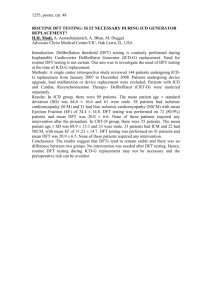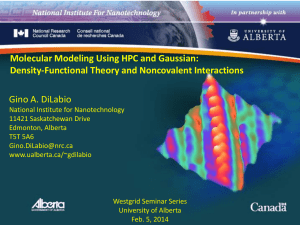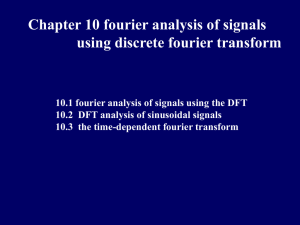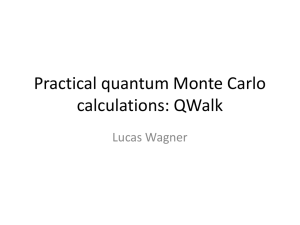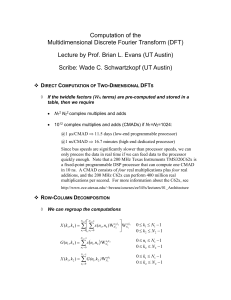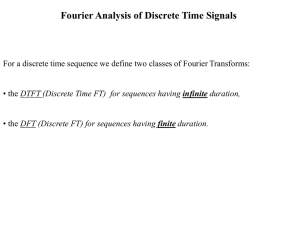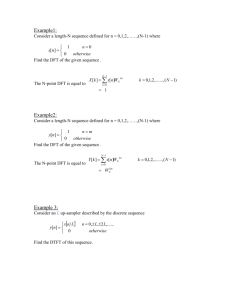IntroductionToSignalProcessing - DCC
advertisement
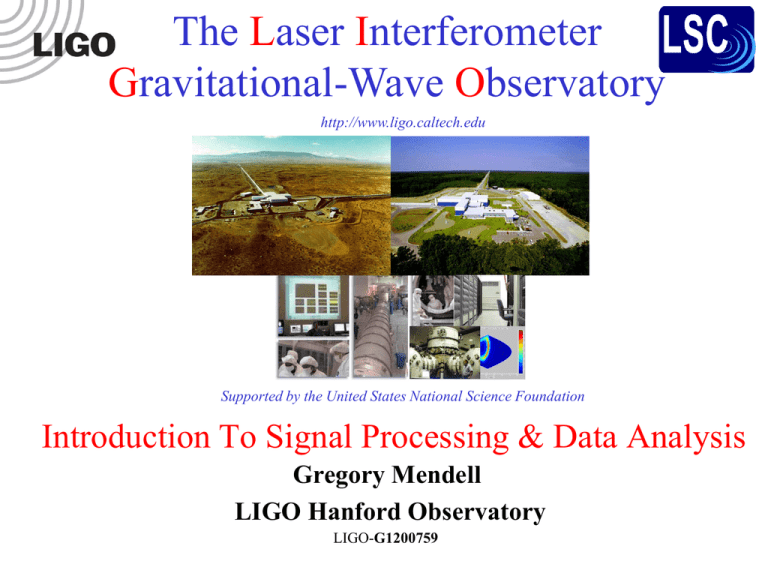
The Laser Interferometer Gravitational-Wave Observatory http://www.ligo.caltech.edu Supported by the United States National Science Foundation Introduction To Signal Processing & Data Analysis Gregory Mendell LIGO Hanford Observatory LIGO-G1200759 Fourier Transforms ~ x ( ) 1 x (t ) 2 x (t )e i t dt i t ~ x ( )e d 2f e it cost i sin t Digital Data x . . . . . j=0 j=1 j=2 j=3 . . … j=4 j=N-1 T t Sample rate, fs: f s 1 /(t ) Duration T, number of samples N, Nyquist frequency: f sT N ; f Nyquist f s / 2 Time index j: t j jt ; Frequency resolution: j 0,1,2,...N 1; f 1 / T Frequency index k: fk k / T ; f kT k ; k 0,1,2,...N 1 Discrete Fourier Transforms (DFT) N 1 2ijk / N ~ xk x j e j 0 1 xj N N 1 2ijk / N ~ xk e k 0 The DFT is of order N2. The Fast Fourier Transform (FFT) is a fast way of doing the DFT, of order Nlog2N. DFT Aliasing f f; ~ x k ~ xk* For integer m: f f m fs ; Useful Band : ~ xk mN ~ xk ; ~ xN k ~ xk* [0, f Nyquist ] k [0, N / 2] Power outside this band is aliased into this band. Thus need to filter data before digitizing, or when changing fs, to prevent aliasing of unwanted power into this band. DFT Aliasing DFT Orthogonality N 1 N 1 N 1 j 0 j 0 j 0 2ijk '/ N 2ijk / N 2ij ( k ' k ) / N 2i ( k ' k ) / N e e e e j N 1 r S r j ; rS r j 1; rS r j ' j 1 r j ' 1 r N ; S 1 r j 0 j 0 j '1 j '0 N 1 e N 1 N 1 2i ( k ' k ) / N j j 0 N 1 2i ( k ' k ) / N N 1 e 1 e 2i ( k ' k ) / N e j 0 N 1 N 2ijk ' / N e 1 e 2i ( k ' k ) 0, k k ' ; N , k k ' 2i ( k ' k ) / N 1 e 2ijk / N N kk ' Parseval’s Theorem N 1 x j 0 N 1 2 j 1 N 1 xj yj N j 0 N 1 ~ xk 2 k 0 N 1 * ~ ~ xk y k k 0 Correlation Theorem N 1 c j' x j y j j' j 0 * ~ ~ ~ c k xk y k Convolution Theorem N 1 C j ' x j y j ' j j 0 ~ ~~ C k xk y k Example: Calibration • • • • • • Measure open loop gain G, input unity gain to model Extract gain of sensing function C=G/AD from model Produce response function at time of the calibration, R=(1+G)/C Now, to extrapolate for future times, monitor calibration lines in DARM_ERR error signal, plus any changes in gains. Can then produce R at any later time t. A photon calibrator, using radiation pressure, gives results consistent with the standard calibration. DARM_ERR G ( f ) C ( f ) D( f ) A( f ) 1 G( f ) R( f ) C( f ) xext ( f ) R( f ) DARM _ ERR( f ) One-sided Power Spectral Density (PSD) Estimation Pk ~ 2 xk 2 t 2 T Note that the absolute square of a Fourier Transform gives what we call “power”. A one-sided PSD is defined for positive frequencies (the factor of 2 counts the power from negative frequencies). The angle brackets, < >, indicate “average value”. Without the angle brackets, the above is called a periodogram. Thus, the PSD estimate is found by averaging periodograms. The other factors normalize the PSD so that the area under the PDS curves gives the RMS2 of the time domain data. Gaussian White Noise n j 0; ~ nk 2 1 N nj N 1 2 1 N N 1 N 1 n j 0 2 j 2 ~ nk n j N k 0 2 2 j 0 Parseval’s Theorem is used above. 2 Power Spectral Density, Gaussian White Noise 2 2 2 N 2t 2 2 2 t Pk fs T P 2 fs This ratio is constant, independent of fs. The square root of the PSD is the Amplitude Spectral Density. It has the units of sigma per root Hz. 2 2 1 N 2 2 2 2 RMS Area f P k 2 N k 0 f s T k 0 N /2 N /2 For gaussian white noise, the square root of the area under the PSD gives the RMS of time domain data. Amplitude and Phase of a spectral line x j A cos(2ft j 0 ) A fT k AN i0 ~ xk e 2 e 2ift j i0 e 2 2ift j i0 If the product of f and T is an integer k, we call say this frequency is “bin centered”. For a sinusoidal signal with a “bin centered” frequency, all the power lies in one bin. DFT Bin Centered Frequency DFT Leakage x j A cos(2ft j 0 ) A fT ; k e 2ift j i0 e 2 2ift j i0 For kappa not an integer get sinc function response: AN i0 sin(2 ) 1 cos(2 ) ~ xk e i 2 2 2 For a signal (or spectral 2 2 2 A N sin ( ) disturbance) with a non2 ~ xk bin-centered frequency, 2 2 4 power leaks out into the neighboring bins. DFT Leakage Windowing reduces leakage Hann Window: 1 2j w j 1 cos 2 N 1 N N N ~ wk k ,0 k ,1 k , 1 ; for 2 4 4 N 1 w w ~ ~ x j w j x j xk ~ xk ' w k k ' N k ' 0 1~ 1~ 1~ w ~ xk xk xk 1 xk 1 2 4 4 N N 1 Corrections to PSD Am plitude Correction: ~x 2 ~x w k k 8 ~w 2 2 ~ Energy Correction: nk nk 3 2 2 2 2 1AT 1 2 ( A / 2) T / 2 1 A (2T / 3) 2 SNR 2 2 Sk 2 2 (3 / 8) S k 2 Sk 3 f f 2 Example PSD Estimation For iLIGO and aLIGO PSD Statistics n~ x iy 2 ~ n x2 y2; ( x, y )dxdy if x y 0; x 2 y 2 1 1 x2 / 2 e 2 1 y2 / 2 e dxdy 2 r x 2 y 2 ; t an1 ( y / x); dxdy rdrd Rayleigh Distribution: 1 r 2 / 2 r 2 / 2 (r , )drd re drd ; (r )dr re dr 2 Chi-squared for 2 degrees of freedom: 1 / 2 2 1 r ; d rdr; ( )d e d 2 2 Histograms, Real and Imaginary Part of DFT For gaussian noise, the above are also gaussian distributions. Rayleigh Distribution Histogram of the square root of the DFT power. Histogram DFT Power Result is a chi-squared distribution for 2 degrees of freedom. Chi-Squared Statistics A chi-squared variable with ν degrees of freedom is the sum of the squares of ν gaussian distributed variables with zero mean and unit variance. x 2 y 2 z 2 ...; r x y z ...; 2 2 2 2 if x y z ... 0 x y z ... 1 2 e.g., dxdydz r sin drdd ; 2 1/ 2 / 2 ( )d e 2 2 r ; d 2rdr 2 d 1 / 2 2 1 ( )d /2 e 2 ( / 2) d Maximum Likelihood Likelihood of getting data x for model h for Gaussian Noise: 1 P ( x | h) e 2 1 ( x1 h1 ) 2 2 12 1 2 2 ( x2 h2 ) 2 e 2 22 1 e 2 3 x jhj 1 hjhj 2 2 2 2 j j 2 j j j j e.g ., h j f (h0 , cos , 0 , ) 2 ( x j h j )2 2 0, h0 2 0, cos 2 0, 0 ( x3 h3 ) 2 2 32 ... Chi-squared 2 0 Minimize Chi-squared = Maximize the Likelihood Matched Filtering x j h j 1 h j h j ~xk*h~k 1 h~k*h~k ln 2 2 j 2 S 2 S j k k j j k k 1 ln ( x, h) (h, h) This is called the log likelihood; x is the data, h is a model of the signal. 2 A2 Maximizing over e.g ., h Ah; ln A( x, h) (h, h) 2 a single amplitude gives: ln / A ( x, h) A(h, h) 0 ~* ~ *~ 2 ~ xk hk hk hk ( x, h ) 1 ( x, h ) A ; ln max ; SNR / ( h, h ) 2 ( h, h ) Sk Sk k k This can be generalized to maximize over more parameters, giving the formulas for matched-filtering in terms of dimensionless templates. Frequentist Confidence Region Matlab simulation for signal: • Estimate parameters by maximizing likelihood or minimizing chisquared • Injected signal with estimated parameters into many synthetic sets of noise. • Re-estimate the parameters from each injection s(t ) A cos2ft B sin 2ft LIGO-G050492-00-W Figure courtesy Anah Mourant, Caltech SURF student, 2003. Bayesian Analysis Bayes’ Theorem: Likelihood: Posterior Probability: Confidence Interval: P ( a ) P ( b | a ) P ( b) P ( a | b) 1 e P( x | h ) 2 1 ( x1 h1 ) 2 2 12 1 2 2 P(h ) P( x | h ) P(h | x ) P( x ) hC C P( h | x )dx 0 Prior e ( x2 h2 ) 2 2 22 ... Bayesian Confidence Region s(t ) A cos2ft B sin 2ft P( A, B; x) exp( 2 / 2) Matlab simulation for signal: Uniform Prior: x LIGO-G050492-00-W Figures courtesy Anah Mourant, Caltech SURF student, 2003. The End

